Sourdough Lebanese Morning Bread (khobz al-Sabah) is a variation of pita bread made with two different types of flours and cornmeal. Using different grains in the dough provides a more interesting texture and flavor than pita made exclusively with wheat flour.

Lebanese Morning Bread is the bake of the month for the Bread Baking Babes. Elizabeth, the host kitchen, based her recipe on the khobz al-Sabah (Lebanese morning bread) from “Savory Baking from the Mediterranean” by Anissa Helou. Anissa learned how to make this bread from an old-fashioned baker in south Lebanon.
Instead of using yeast as the leavening, Elizabeth added an overnight sourdough levain which allows for a longer fermentation and gives the bread an additional boost in texture and flavor.
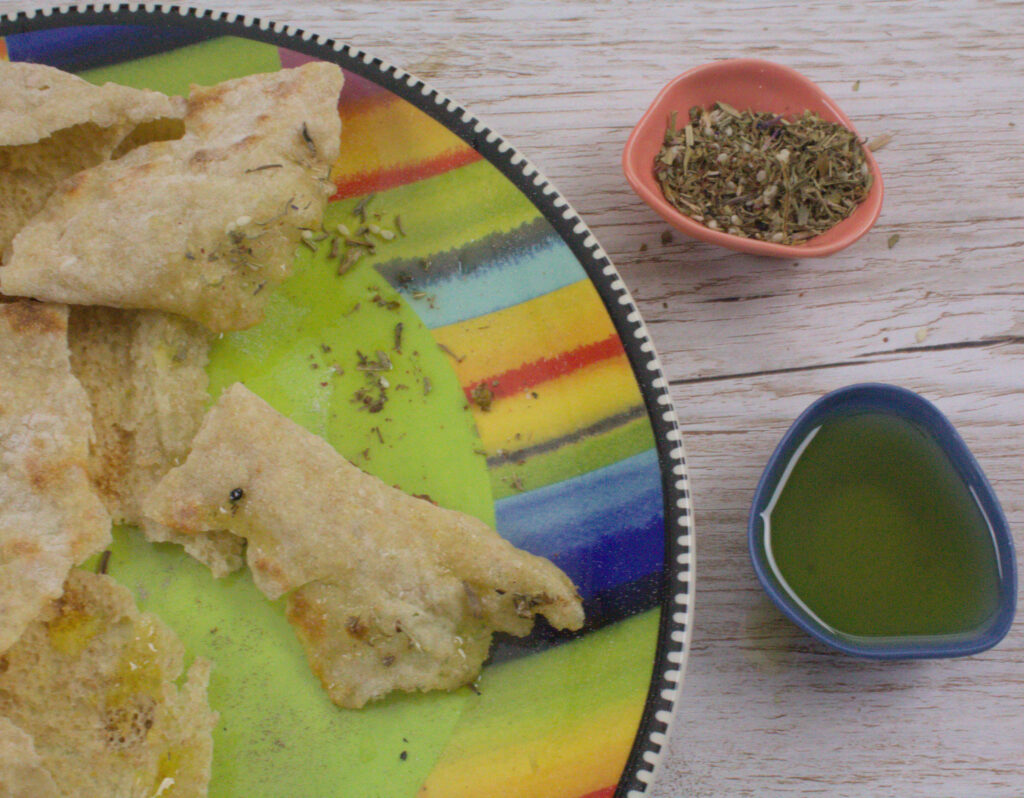
What types of flour can be used in this khobz al-Sabah?
You can use any type of whole wheat flour to prepare the leaven. The dough can be made using only wheat flours, but adding different types of grains (cornmeal, millet, barley, teff, or even chickpea flour) will give it added appeal.
I used home-milled whole grain spelt flour in the leaven and the dough, as well as all-purpose, and stone ground cornmeal from a local mill. I included a bit more whole grain than the adapted recipe suggested. The added whole grain makes it a bit denser.
Adding barley flour or meal is an interesting alternative to the cornmeal. I would like to try the barley version sometime. Elizabeth used it successfully, and I bet it had a great flavor.
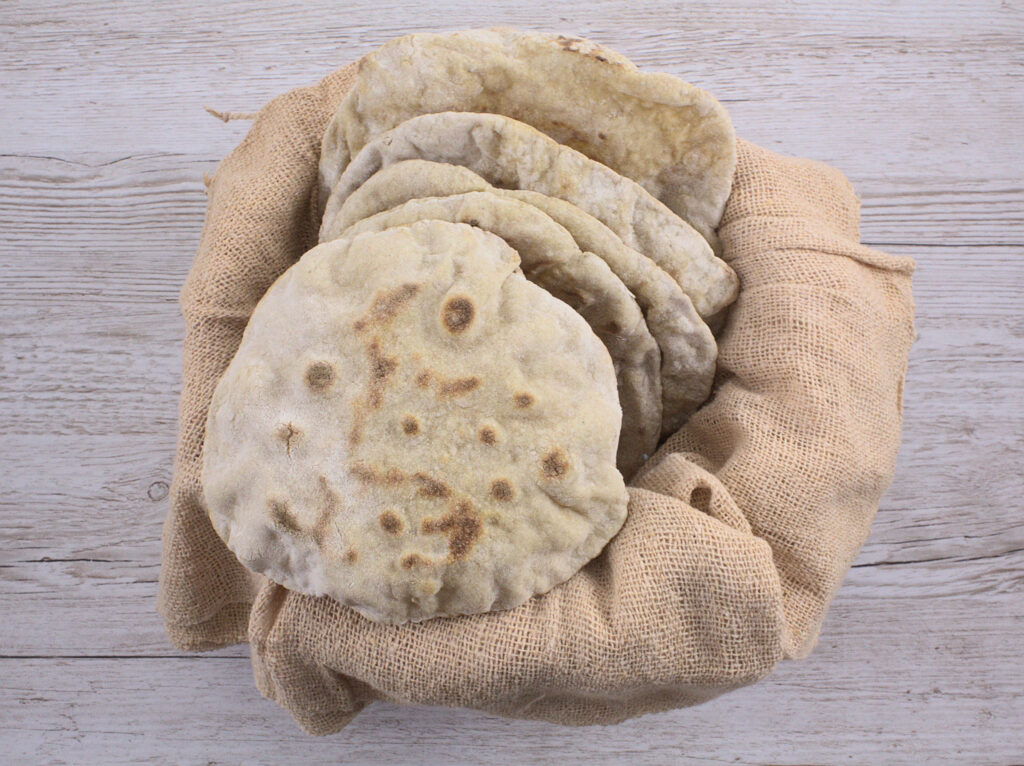
What do you serve with Sourdough Lebanese Morning Bread?
Here are some resources Elizabeth shared with us:
“[B]read is a traditional Lebanese breakfast option[…] often served with eggs, hummus, cheese spread, or just za’atar spice”- Nomads Unveiled | 15 Lebanese Breakfasts: A Look at Breakfast in Lebanon
————————
“Nothing beats this traditional Lebanese breakfast made up of thick, creamy labne and olive oil, cheese (baladi, halloumi, akkawi… or all of the above), olives, zaatar, cucumbers, tomatoes from the “day3a” [village], fresh mint leaves, Lebanese bread, and tea”- Christina Naim, Beirut.com | 9 Lebanese Breakfasts Ranked In Order Of Deliciousness
————————
Foul (ful) medames is a hearty Lebanese breakfast made from cooked fava beans, lemon juice, crushed garlic and cumin served with fresh vegetables and eaten with pita bread. Most often, it is simply referred to as “foul”. – Iman, Simply Lebanese | Foul (Ful)
————————–
Homemade pita is amazing, but couple that with some fresh produces to prepare a lavish Lebanese breakfast to make it the best. […]I love to have a healthy and big breakfast.
Lebanese Breakfast Spread:
• Fresh colorful peppers, julienned
• Labneh, drizzled with olive oil and garnished with parsley
• Hard Boiled Eggs
• Persian Cucumbers, chopped
• Honey
• Tahini
• Fresh Tomatoes
• Olives
• Cumin, Salt and Chile powder mix for eggs
Tea and Sugar for tea– Dolphia Nandi Arnstein, Story of Cooks | Pita and Lebanese breakfast.
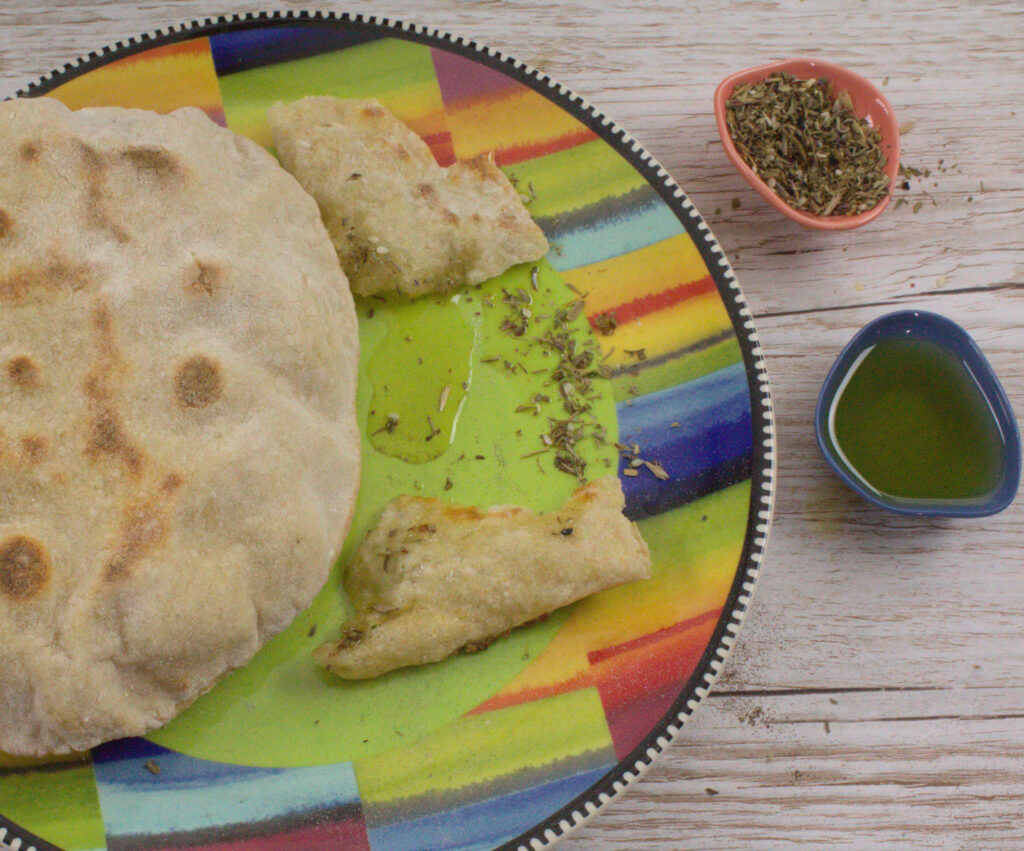
Suggested Timing for making Lebanese Morning Bread:
Option 1: To enjoy these pitas for dinner, follow the suggested timeline:
Evening Day 1: Start the Leavener
Morning or Afternoon Day 2: Make the Dough, Proof, Shape
Evening Day 2: Bake the Pitas
Option 2: If you want the pita bread fresh for breakfast, perform the two steps the day before (create leavener and make final dough), and then bake them the next morning.
Morning Day 1: Feed levain
Afternoon Day 1: Make the dough. Perform the stretch and folds, and then let the dough sit for an hour before refrigerating the bowl of dough it overnight.
Or, let the dough bulk ferment, then divide & shape into six balls, transfer the balls to a baking sheet, cover and place in the refrigerator overnight.
Morning Day 2: Shape and bake the Lebanese morning bread.

Cathy’s notes on making these sourdough pitas:
I used a combination of both options above. I incorporated the overnight levain, but after the bulk ferment, I shaped the balls and let them cold ferment in the refrigerator overnight. I baked them for breakfast the next morning.
It was a bit tricky working with the cold fermented dough. It fermented too long and was a bit too moist. I had to add a good bit of flour to roll out the pitas. This affected the texture and flavor. Next time, I will use less water in the dough. I think the cold fermentation overnight will work if the dough is less hydrated and spends less time fermenting on the counter. I’ll have to test that.
other references:
• Kalofagas | How to Make Pita Bread
• Serious Eats | Homemade Pita Bread Recipe
• The Kitchn | How To Make Pita Bread at Home
• blog from OUR kitchen | We cannot stop making pita
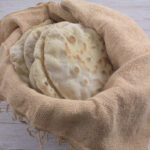
Sourdough Lebanese Morning Bread | khobz al-Sabah Pita
- Yield: 6 Pitas 1x
Description
This Sourdough Lebanese Morning Bread is a variation of pita bread made with two different flours and cornmeal. Using different grains in the dough provides a more interesting texture and flavor than pita made exclusively with wheat flour.
Ingredients
Leavener
- dessert spoonful sourdough starter from the fridge (about 25 grams)
- 50 grams [50 ml] room temperature water (plus more as needed)
- 50 grams [1/4 cup + 1 Tbsp.] 100% whole grain spelt flour
Dough
- 200 grams [~1 1/2cups] unbleached all-purpose flour (plus more for sprinkling)
- 50 grams [1/4 cup + 1 Tbsp.] whole grain spelt flour
- 50 grams [1/3 cup] cornmeal
- 160 grams [160 ml (1/2 cup + 2 Tbsp. +2 tsp.)] water
- all of the leavener from above (when it floats – showing that it’s as strong as it can be)
- 7 grams [generous teaspoon] sea salt + 10 grams [2 teaspoons] water
Instructions
Leavener:
- Late in the evening on the day before you will be making the bread, put a spoonful of culture from the fridge into a small bowl. Stir in 50 grams water and 50 grams whole wheat flour. Cover and let it rest overnight in at warm room temperature.
Actual Dough:
- Perform the float test. On the day you will be making the bread, check to see if the leavener floats in a small bowl of cool water. If the leavener is domed but it doesn’t float, wait for 30 minutes or so and try again. If the leavener is bubbly but flat or concave on the surface, stir in about 5 grams each of whole wheat flour and water. Cover, and leave on the counter out of droughts. Check again for floating about 20-30 minutes later. It will probably float. Proceed with making the actual dough.
- Using a bowl that is large enough for the dough to triple, whisk together the all-purpose flour, spelt flour and corn meal. Add 160 grams of water and all of the leavener. Using a dough whisk or wooden spoon, stir just enough to mix it together. Add in additional water, a little at a time, if needed, until there are no dry bits of flour. Cover and let rest on the counter for 20-30 minutes.
Kneading and adding the salt:
- Whisk salt and 10 grams water into a small bowl and pour on top of the dough. Wash your hands and leave one hand wet. With the back of your hand against the side of the bowl, reach down into the bowl to the bottom of the dough and pull it up to the fold it over the top. Turn the bowl with your other hand and repeat 4 or 5 times. Cover the bowl with a plate and set aside on the counter for about 20 minutes.
- Repeat the previous step 2 or 3 times more. You’ll notice that the dough becomes smooth and silky to the touch. It may also seem a little dry. Don’t be overly concerned. Just add a splash more water and squoosh it in.
Proofing:
- Cover and leave on the counter. (Check the dough every so often as the afternoon progresses into evening. If you’re not ready to bake the bread, wet your hands and gently fold the dough whenever it has doubled.
Preheat:
- The pita can be baked in the oven or on a grill.
- Baking on the grill: When you’re ready to bake the pita, light the grill, close the lid, and turn on high.
- Baking in the oven: Place a pizza stone or baking steel on the middle shelf of the oven set at 450F.
Shaping:
- While the grill/oven is preheating, transfer the risen dough to a lightly floured board. Divide the dough evenly into 6 pieces. Using floured hands, shape each piece into a round. Cover with a damp tea towel and allow to rest for about 5 minutes.
- Starting with the first round, use a rolling pin to roll the round into a disc about 6 inches (15cm) in diameter. As you roll, make sure that the disc can be lifted up easily. Repeat with all the rounds.
Baking:
- When the grill/oven is hot hot hot, carry the board of rounds and, use a bench scraper, to transfer the rounds to the grill or oven.
- If using the grill: place each round directly on the grill and close the lid. After a minute or so, use blunt-nosed tongs to move the rounds from place to place, to account for uneven heat. The bread should puff up. Don’t get too worried if a balloon bursts as you move the pita and enjoy the show of steam escaping. Even if it is flat, the pita will still taste good!
- If using the Oven: place each round on the preheated stone or steel. Keep the oven temperature at high heat (450F). It takes 5-10 minutes to bake the breads. When they balloon up, gently turn them over. Also, move them around from time to time to account for uneven heat in oven. USE OVEN MITTS AND TONGS!!
- To check if the breads are done, use blunt-nosed tongs to gently lift them up. They should be light weight and puffy. As they are done, put them into a basket.
- Serve immediately.
- Category: Sourdough Pita Bread
- Cuisine: Middle Eastern
Who are the Bread Baking Babes?
We are a group of bread bakers who get together every month and bake bread! We have a Facebook group if you’d like to bake along. New recipes are posted every month on the 16th.
Elizabeth, of blog from OUR kitchen, is the host kitchen this month. If you want to bake along with us as a Buddy, check out her blog for details on how to participate. She’ll send you a Buddy badge, and feature you in the round-up. Deadline to get your e-mail to her is September 29th.
Check out the different variations for the Sourdough Lebanese Morning Bread:
blog from OUR kitchen– Elizabeth (host kitchen)
Karen’s Kitchen Stories – Karen
Bread Experience – Cathy
A Messy Kitchen – Kelly
Judy’s Gross Eats – Judy
My Diverse Kitchen – Aparna
Thyme for Cooking – Katie (roundup)

Happy Baking!
Cathy
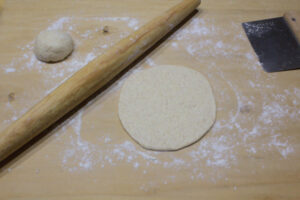
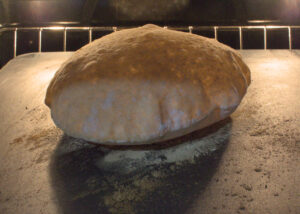
Elizabeth says
Your spelt breads look wonderful. I bet they were delicious with olive oil and za’atar.
Thank you for pointing out how to prepare for baking in the morning. I was lazy and just baked them the night before, then reheated them in the toaster.
Barley flour instead of cornmeal did work really well – I thought the bread tasted better that way too.
Cathy says
Thanks! They were delicious with the olive oil and za’atar.